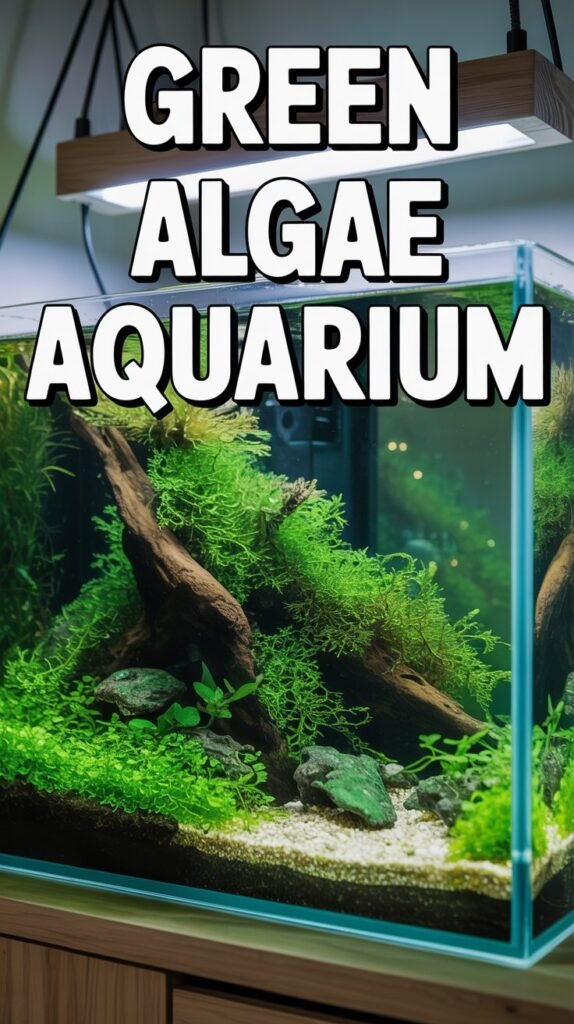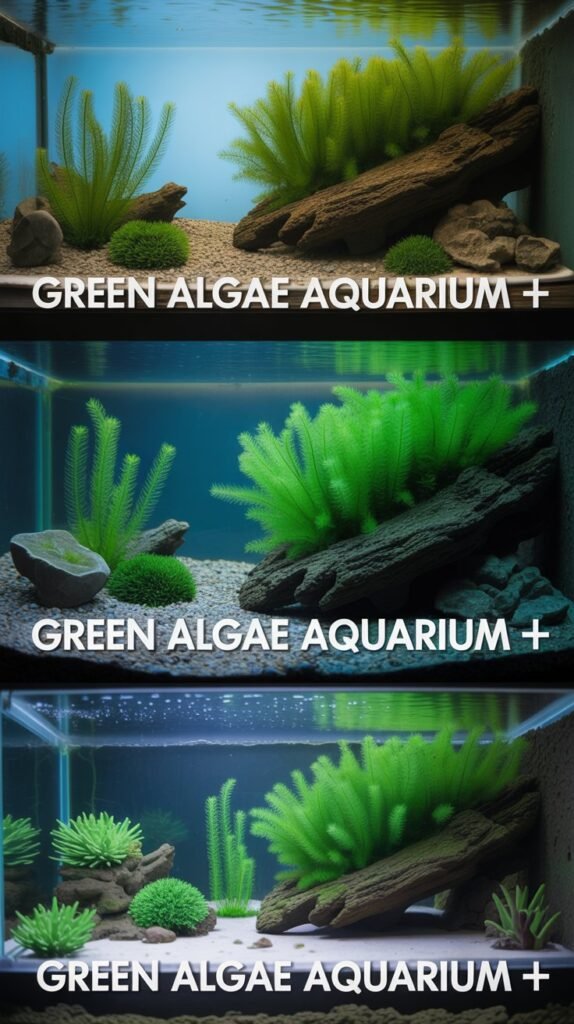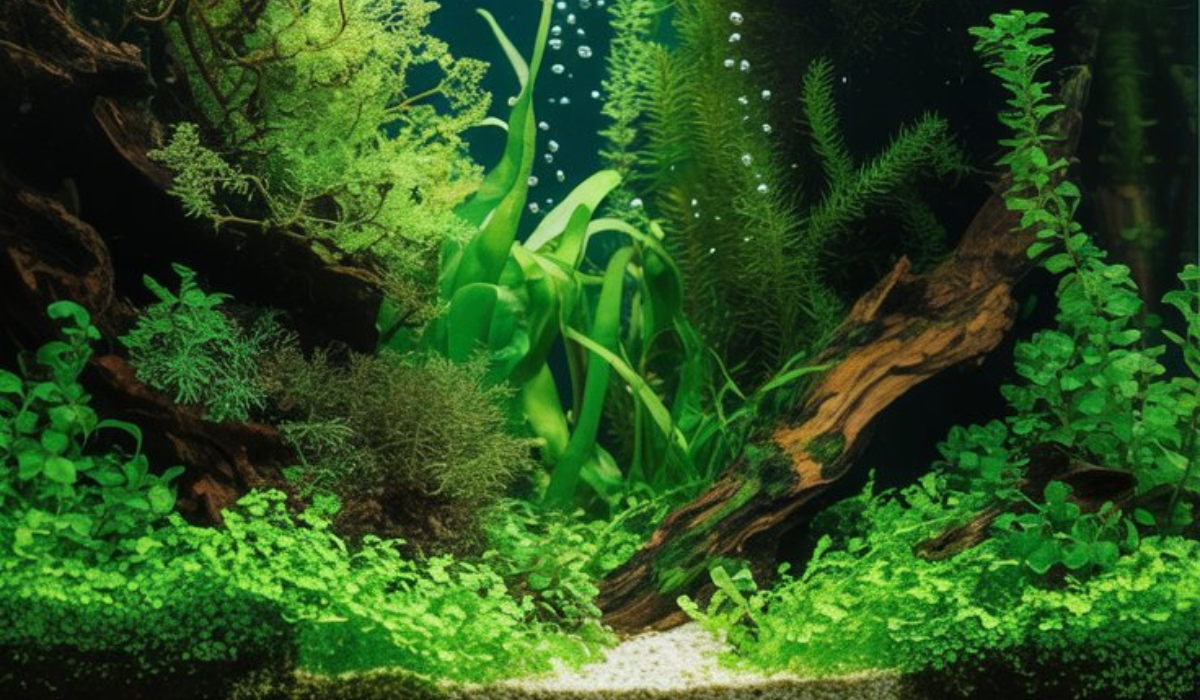Aquariums are miniature ecosystems that thrive on balance — between light, nutrients, and aquatic life. But when that balance is disturbed, one of the most common problems aquarists face is green algae growth. While algae are a natural part of every aquarium, excessive growth can cloud your water, smother plants, and make your tank look unhealthy.
In this comprehensive guide, we’ll explore everything you need to know about green algae in aquariums — what causes it, how to control it, how to prevent it from coming back, and even when it can be beneficial.
What Is Green Algae?
Green algae (Chlorophyta) are microscopic plant-like organisms that grow in freshwater and marine aquariums. They perform photosynthesis, using light, carbon dioxide, and nutrients to produce oxygen — just like live plants. In moderate amounts, green algae are harmless and even beneficial to aquatic ecosystems.
However, when conditions are favorable — such as too much light or excess nutrients — green algae can grow rapidly, turning your tank water green or coating surfaces like glass, rocks, and decorations with a slimy layer.
Types of Green Algae Found in Aquariums

There isn’t just one type of green algae. Understanding the different varieties can help you identify the problem and take appropriate action.
1. Green Water (Free-Floating Algae)
This type of algae causes the aquarium water to turn cloudy green, often called an algae bloom. It’s made up of millions of microscopic algae cells suspended in water. While not directly harmful to fish, it blocks light from reaching plants and can disrupt the tank’s ecosystem.
Causes:
- Excess nutrients (especially nitrates and phosphates)
- Direct sunlight exposure
- Overfeeding or decaying organic matter
2. Green Spot Algae (GSA)
These algae form small, hard green dots on aquarium glass, plant leaves, and decorations. They’re tough to remove and indicate an imbalance, often related to phosphate levels.
Causes:
- Low phosphate concentration
- Excessive light exposure
- Inconsistent maintenance
3. Green Dust Algae (GDA)
GDA appears as a soft green film covering the aquarium glass. It can be easily wiped off but often returns quickly if underlying issues aren’t fixed.
Causes:
- Unstable nutrient levels
- New tank syndrome
- Too much light or poor water flow
4. Hair or Thread Algae
These are long, stringy, green filaments that grow on plants, rocks, or decorations. They can quickly entangle live plants and block light.
Causes:
- Imbalanced CO₂ and nutrients
- Strong light exposure
- Overfeeding or poor water changes
5. Staghorn and Cladophora Algae
These are stubborn, branching algae that attach tightly to surfaces and are difficult to remove. They thrive in tanks with unstable CO₂ levels and low water movement.
What Causes Green Algae in Aquariums?
Green algae growth is always the result of imbalance. To prevent it, you need to understand the main contributing factors:
1. Excess Light
Light is essential for photosynthesis — but too much of it triggers algae blooms. Keeping your aquarium lights on for more than 10–12 hours a day or placing your tank near direct sunlight encourages algae growth.
2. Nutrient Imbalance
Excess nutrients like nitrates and phosphates from fish waste, uneaten food, and decaying plants serve as fertilizer for algae.
3. Overfeeding
Overfeeding fish not only pollutes the tank but also provides extra nutrients for algae. Uneaten food decomposes and raises nutrient levels.
4. Poor Water Maintenance
Skipping water changes allows waste to accumulate, leading to nutrient spikes. Infrequent cleaning also allows algae spores to thrive.
5. Unstable CO₂ Levels
In planted tanks, low or fluctuating CO₂ promotes algae growth, especially on leaves and decorations.
6. Lack of Competition
If your aquarium doesn’t have enough live plants, algae will outcompete for nutrients and light, quickly dominating the tank.
Is Green Algae Bad for Aquariums?
Not necessarily. In moderation, green algae have several benefits:
- Produce oxygen during the day through photosynthesis
- Serve as a natural food source for algae-eating fish and invertebrates
- Indicate ecosystem balance, especially in new tanks
However, excessive green algae are a warning sign of imbalance and can cause problems like:
- Blocking light from reaching plants
- Reducing oxygen at night
- Smothering live plants and decorations
- Making the tank look unappealing
So, while small amounts are normal, overgrowth needs control.
How to Remove Green Algae from Your Aquarium

Here’s a step-by-step guide to safely eliminate green algae without harming your fish or plants.
1. Manual Cleaning
Physically remove algae from glass, decorations, and rocks.
- Use an algae scraper or magnetic cleaner for glass.
- Remove decorations and scrub them gently with an aquarium brush.
- Rinse with tank water, not tap water, to preserve beneficial bacteria.
2. Perform Regular Water Changes
Change 20–30% of the tank water weekly to reduce nutrient buildup. This helps dilute excess nitrates and phosphates that feed algae.
3. Control Lighting Duration
- Limit light exposure to 8–10 hours daily.
- Use a timer for consistent light cycles.
- Avoid placing the tank near a window or direct sunlight.
4. Maintain Proper Feeding Habits
Feed fish only what they can consume in 1–2 minutes, once or twice daily. Remove uneaten food promptly to prevent decay.
5. Balance Nutrients
Maintain consistent nitrate (10–30 ppm) and phosphate (0.5–1 ppm) levels for planted tanks. Too little or too much can trigger algae.
6. Add Live Plants
Live plants naturally compete with algae for light and nutrients, helping to suppress unwanted growth. Fast-growing species like Hornwort, Anacharis, or Water Wisteria are especially effective.
7. Introduce Algae-Eating Species
Several aquarium inhabitants can help control green algae naturally:
Fish:
- Siamese algae eater
- Otocinclus catfish
- Bristlenose pleco
- Mollies
Invertebrates:
- Amano shrimp
- Nerite snails
- Mystery snails
They graze on algae, keeping the tank clean while adding diversity.
8. Adjust CO₂ Levels
For planted tanks, ensure stable CO₂ injection or supplementation. Unstable CO₂ encourages algae to flourish on plant leaves.
9. Maintain Filter and Flow
Clean filters regularly to remove detritus and ensure proper water flow. Good circulation prevents stagnant areas where algae thrive.
10. Use Aquarium-Safe Tools or Treatments (Last Resort)
If algae persist despite proper maintenance, you can use aquarium-safe algae removers or UV sterilizers. However, use them sparingly — overuse can harm plants and beneficial bacteria. Natural control and balance are always preferable.
Preventing Green Algae in Your Aquarium
Prevention is always easier than removal. Follow these tips to keep green algae under control permanently:
1. Maintain Regular Water Changes
Consistent 20–30% weekly water changes remove excess waste and stabilize water chemistry.
2. Balance Light and Shade
Don’t exceed 10 hours of light per day. If using high-intensity lighting, consider floating plants or light-diffusing covers.
3. Monitor Nutrient Levels
Test your water weekly for nitrate and phosphate levels. Use high-quality test kits to detect imbalances early.
4. Avoid Overcrowding
Too many fish mean more waste, leading to algae problems. Follow the rule of 1 inch of fish per gallon as a general guideline.
5. Use a Timer
Timers help maintain a consistent light schedule, preventing excessive algae growth due to irregular lighting cycles.
6. Clean Tank Equipment Regularly
Dirty filters and decorations harbor organic buildup that feeds algae. Clean them regularly using tank water.
7. Increase Plant Density
The more live plants you have, the less chance algae have to dominate. Plants like Java Fern, Anubias, and Amazon Sword absorb excess nutrients effectively.
8. Quarantine New Additions
Algae spores can hitchhike on plants, decorations, or even fish. Rinse or quarantine new items before adding them to your tank.
Natural Methods to Control Green Algae
If you prefer not to use chemicals, here are some eco-friendly and natural methods to keep algae growth in check:
1. Reduce Lighting Intensity
Dim your aquarium lights or shorten the duration to reduce photosynthesis.
2. Introduce Floating Plants
Plants like duckweed, water lettuce, or frogbit shade the tank and absorb nutrients.
3. Maintain a Healthy Biofilter
A strong colony of beneficial bacteria helps break down waste efficiently, reducing nutrient buildup.
4. Use UV Sterilizers
A UV sterilizer kills free-floating algae spores (green water) before they multiply.
5. Maintain Consistent CO₂ Injection
For planted aquariums, CO₂ systems help plants outcompete algae for nutrients.
The Role of Algae in a Healthy Aquarium
While often viewed as a nuisance, algae play important roles in aquarium ecosystems:
- Oxygen production during daylight
- Natural food source for algae eaters
- Indicator of tank maturity (new tanks often experience algae cycles)
In moderation, a light coating of green algae on rocks or glass is completely normal and even beneficial. The goal isn’t to eliminate algae entirely but to maintain balance.
Troubleshooting Persistent Green Algae
If you’ve tried everything and algae still return, review these potential issues:
- Inconsistent Maintenance: Missing water changes or filter cleaning leads to nutrient spikes.
- Too Much Light: Even high-quality LED lights can cause algae if used excessively.
- Imbalance Between CO₂ and Nutrients: Plants need both; imbalance favors algae.
- Old Bulbs: Aging lights shift spectrum, encouraging algae growth.
- Low Plant Growth: Weak or slow-growing plants mean more resources available for algae.
Identifying and fixing the root cause is key to long-term success.
Quick Summary: Green Algae Management Checklist
✅ Limit lighting to 8–10 hours/day
✅ Perform weekly 20–30% water changes
✅ Feed fish sparingly
✅ Introduce algae eaters
✅ Maintain stable CO₂ levels
✅ Balance nutrients (Nitrate: 10–30 ppm, Phosphate: 0.5–1 ppm)
✅ Use fast-growing live plants
✅ Avoid direct sunlight exposure
By following these steps, you can maintain a clear, balanced, and visually stunning aquarium.
Conclusion
Dealing with green algae in aquariums is a natural part of fishkeeping. Instead of viewing algae as an enemy, think of it as an indicator — a sign that something in your tank’s ecosystem is out of balance.
With proper maintenance, balanced lighting, and good water quality, you can keep algae under control and enjoy a vibrant, healthy aquarium. Whether you’re a beginner or a seasoned aquarist, understanding the causes and cures of green algae is essential for long-term success.
Remember: prevention, not reaction, is the key to a beautiful, algae-free aquarium.
FAQs About Green Algae in Aquariums
1. What causes green algae to grow in an aquarium?
Green algae grow due to excess light, high nutrient levels (nitrates and phosphates), and poor maintenance habits like overfeeding or infrequent water changes.
2. Is green algae harmful to fish?
No, it’s generally harmless in small amounts. However, excessive algae can reduce oxygen at night and block light for live plants.
3. How do I get rid of green water in my aquarium?
Perform water changes, reduce lighting, and use a UV sterilizer to clear free-floating algae. Balancing nutrients also prevents recurrence.
4. Can I leave green algae in my tank?
Yes, a small amount is fine and even beneficial. Just prevent it from overgrowing and covering all surfaces.
5. What fish eat green algae?
Algae-eating fish like Otocinclus catfish, Siamese algae eaters, bristlenose plecos, and mollies help control algae naturally.
6. Does direct sunlight cause algae growth?
Yes, direct sunlight accelerates algae growth. Keep your aquarium away from windows to prevent unwanted blooms.
7. How often should I clean my tank to prevent algae?
Weekly partial water changes and monthly deep cleaning help keep algae under control.
8. Can live plants help reduce algae?
Absolutely. Live plants compete for nutrients and outcompete algae when properly maintained.
9. Are chemical algae removers safe?
They can be effective but should be a last resort. Overuse can harm plants and beneficial bacteria.
10. How can I permanently prevent green algae?
Maintain balance: control light exposure, feed properly, perform regular water changes, and keep healthy plant growth
In summary:
A green algae aquarium isn’t always a bad thing — it’s a sign of a living, breathing ecosystem. The key lies in managing balance through consistent maintenance, proper lighting, and nutrient control. With these strategies, your aquarium will stay clear, healthy, and beautiful all year round.

